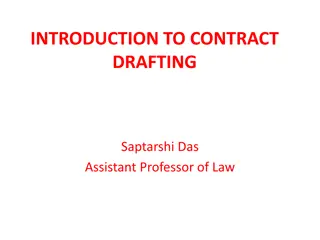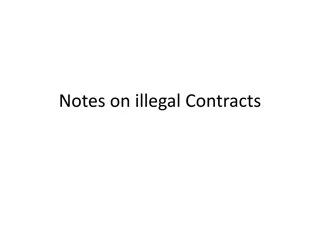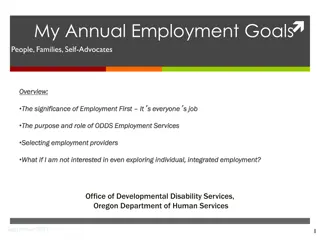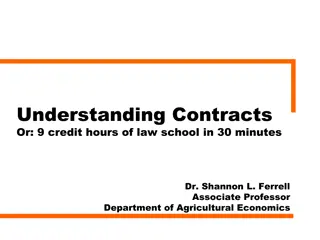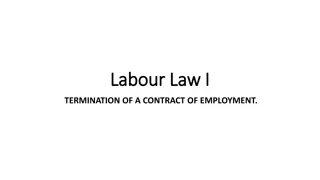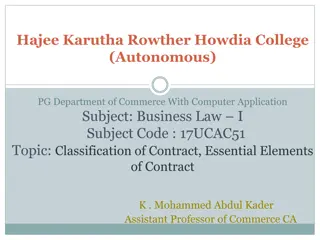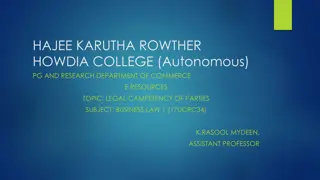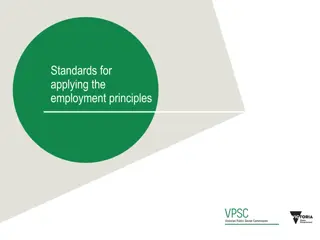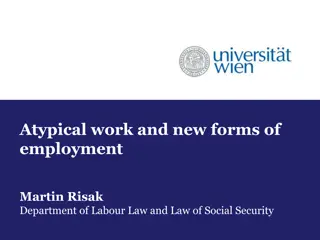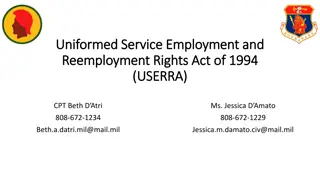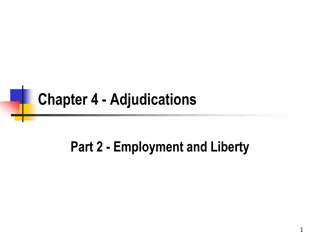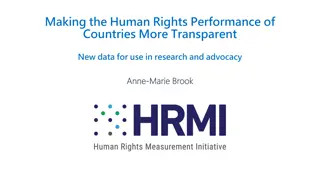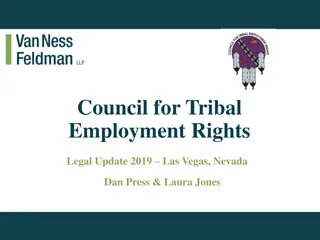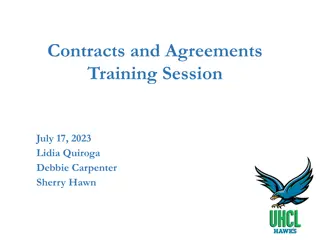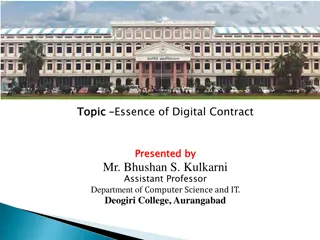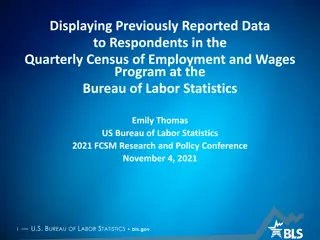Understanding Employment Contracts and Rights in Business
Exploring the different types of employment contracts, rights, and obligations for employees and employers. Topics include contract terms, hiring arrangements, express and implied terms, as well as details on wages, dismissals, and employer insolvency.
Download Presentation

Please find below an Image/Link to download the presentation.
The content on the website is provided AS IS for your information and personal use only. It may not be sold, licensed, or shared on other websites without obtaining consent from the author. Download presentation by click this link. If you encounter any issues during the download, it is possible that the publisher has removed the file from their server.
E N D
Presentation Transcript
Contract of service- employee contract Contract for service- contractors contract
Do they have to do the work themselves? Can someone tell them at any time what to do, where to carry out the work or when and how to do it? Can they work a set amount of hours? Can someone move them from task to task? Are they paid by the hour, week, or month? Can they get overtime pay or bonus payment?
Can they hire someone to do the work or engage helpers at their own expense? Do they risk their own money? Do they provide the main items of equipment they need to do their job, not just the small tools that many employees provide for themselves? Do they agree to do a job for a fixed price regardless of how long the job may take? Can they decide what work to do, how and when to do the work and where to provide the services? Do they regularly work for a number of different people? Do they have to correct unsatisfactory work in their own time and at their own.
Express terms Can arise informally by word of mouth but should be provided in writing within two months of employment (s1 of the Employment Rights Act 1996 (ERA 1996)); failure to provide this does not invalidate the contract Implied terms Custom and practice; Works and staff rules Collective agreements Statute Common law rights and duties of employers and employee Express terms Implied terms
Employment Particulars Wages and Payment Disclosure and Detriment Sunday s betting Time off and suspensions Child care Dismissals notice and reasons Unfair dismissals Redundancy Payment Employer Insolvency
Parties names Date when the employment began Note of any disciplinary and grievance procedures Full particulars of: pay entitlement; hours of work; holiday entitlement; sick leave; pension rights; length of notice to be given to and by the employer; title of the employee s job and job description; length or duration of employment; place where the employee is expected to work
Custom and practice Custom and practice- - Work and staff rules Not necessarily terms of the contract but failure to obey these rules is likely to be treated as evidence of failure to obey reasonable orders Collective agreements An agreement between union and employer may expressly or impliedly form part of employment contract Work and staff rules Collective agreements
Statute Legislations increasingly restricts employers freedom to impose terms of their choice on employees Terms implied at common law Common law imposes duties on both employer and employee (Tort) Statute Terms implied at common law
3. Some Terms implied by statute. Gives employees certain rights, such as a right not be unfairly dismissed, a right to a redundancy payment if made redundant and a right to a minimum period of notice to terminate the contract. Limit the hours of work to an average of 48 a week. It also gives the right to four ERA 1996 Working Time Regulations 1998 weeks paid leave a year and one day off each week. Gives parents of childern under six the right to request flexible working arrangements. The employer mut give serious consideration to such a request and can only reject it for clear business reasons. The Act also introduced paternity and adoption leave . Deals not only with pay, but other terms, e.g. holiday and sick leave. Implies an equality clause into all contracts of employment if workers of the opposite sex do the same job or a different job of equal value. Employment Act 2002 Equal Pay Act 1970 National Minimum Wage Act 1998 Imposes minimum levels of pay
The employee should: Do their job with reasonable skill and care Reasonable standards depends the status of the employee in the organisation Obey all reasonable orders So long as it does not require the employee to do something outside of the job description, unless stipulated in the employee contract There is no endangerment to the personal safety or liberty of the employee Does not break the law Act in good faith towards the employer Not to act in conflict with employee interest Not to reveal confidential information To account for all profits Do their job with reasonable skill and care Obey all reasonable orders Act in good faith towards the employer
It is implied in the contract of employment that the employer will: P Pay the employee as agreed by the contract; Most employees are entitled to a minimum wage under the Minimum wage Act 1999 (amended in 2010) Obligation to pay employee exists whether or not the employer has provided work Not undermine the trust and confidence of the employee Several things fall under this obligation including failure to provide support to employees at busy times, criticising a supervisor or superior before his subordinates, or failure to protect the employee against harassment Breach of this duty may be grounds for a claim and the employee can leave without notice Provide the employee with safe working conditions Health and safety must be observed in the workplace Liability for breach of this duty is imposed through the law of tort at both common law and statute ay the employee as agreed by the contract; Not undermine the trust and confidence of the employee Provide the employee with safe working conditions
Two possible rights of action in tort may be open to an employee injured at work: An action for breach of the employer s common law duty of care An action for the breach of statutory duty Eg. Health and Safety Stress at Work
There are three interlinked obligations: 1. To provide competent staff 2. To provide safe premises (Knowles v Liverpool CC (1993)) 3. To provide a safe system of work (Walker v Northumberland County Council, 1995)
Tort duty owed when problem known or should have been known] Tort negligence duty owed when problem known or should have been known] negligence duty of care duty of care overworked schoolteacher overworked schoolteacher D the council which employed C a 52 year old schoolteacher as head of mathematics in a comprehensive school. He worked long hours about which he complained of work overload . Following a period of sickness because he was overstressed/depression he suffered a mental breakdown at school. Held caused the claimant s nervous breakdown. The employer s duty to take some action arose when the claimant saw separately each member of the school s senior management team. It continued so long as nothing was done to help the claimant. The senior management team should have made inquiries about his problems and seen what they could have done to ease them, instead of brushing him off unsympathetically or sympathising but simply telling him to prioritise his work. Stokes v Guest, Keen and Held: The school owed C a duty of care, and their breach of that Stokes v Guest, Keen and Nettlefold Nettlefold (Bolts and Nuts) Ltd [1968] (Bolts and Nuts) Ltd [1968]
The Health and Safety Act 1974 covers specific areas of workplace safety. It is important in three respects: 1. It imposed general duties on both employers and employees to maintain health and safety; 2. It created the Health and Safety Executive, with powers to enforce the legislation; 3. It gave wide powers to the Department of Works and Pensions to make detailed legally binding regulations to cover particular hazards
Equal Pay Act 1970 amended in 1983 Sex Discrimination Act 1975 Race Relations Act 1976 amended 2000 Disability Discrimination Act 1995 amended 2003
At present the minimum hourly rate is set at 5.93. Workers aged 18 or over but who have not reached 22 are entitled to a minimum hourly rate of 4.92. Workers who are above compulsory school age but have not reached their 18th birthday are entitled to 3.64/ hour.
Required that women be paid the same rate as any man in the workplace who is doing The same or similar work; Work which is rated as equivalent work by a job evaluation scheme Work of equal value
It is illegal to discriminate directly or indirectly against persons on the grounds of their sex or marital status. It includes: Direct discrimination grounds of her sex less favourably than a man Sexual harassment a complainant could succeed on proof Indirect discrimination and Burden of Proof) Regulation: s (2)(b): concerned with covert discrimination e.g. height restriction, that excludes the majority of a sex. Discrimination on the grounds of marital status: can not be treated differently because of their marital status. Discrimination on grounds of victimisation someone differently because they have asserted their rights under any Act Direct discrimination s1(1)(a) is if a woman is treated on the Sexual harassment- -not specifically identified in the SDA 1975; but Indirect discrimination-amended 2001 by the Sex Discrimination Discrimination on the grounds of marital status: s 3- a person Discrimination on grounds of victimisation: s 4 (1)- illegal to treat
Discrimination can come into play in relations to employment in some of the following ways: Advertising jobs Interviewing and selection procedures Training Promotion Other facilities available to employees ( like canteen, social club or medical services) Membership of trade unions and professional bodies
Certain qualities such as strength and stamina are not treated as sex specific. The burden of proving that the GOQ lies with the employer and is possible as follows: The essential nature of the job to play a male role in a play; or a male model for a nude exhibition Issues of privacy Lack of facilities- if the job requires workers to live on the premises and facilities can only be provided for one sex Single-sex hospitals or prisons- employing persons of one sex to care for patients etc. The essential nature of the job- - i.e. a man may need Issues of privacy: lavatory or locker room attendants
Pregnancy and Parental responsibility protected under the SDA 1975; the Equal Treatment Directive (76/207/EEC) and the Pregnancy Workers Directive (92/85/EC) and ERA 1999 Pensions 1995 ss 62-66 Gender reassignment Directive(76/207/EEC); SDA 1975 amended to protect transsexuals Pregnancy and Parental responsibility- - Pensions EPA 1970, SDA 1975, Pensions Act Gender reassignment- - Equal Treatment
Under the Maternity and Parental Leave Regulations 2002 pregnant employees are entitled to paid time off for antenatal care. In addition, pregnant employees are entitled to 52 weeks maternity leave. This consists of 26 weeks Ordinary Maternity Leave and 26 weeks Additional Maternity Leave. Paternity Leave right for the partner of the mother or adopter leave to take up to two weeks paternity leave. The partner could be the father, or someone (either female or male) who lives in an enduring family relationship with the mother or adopter. In order to be eligible for the leave, the partner must have been employed for not less than 26 weeks prior to the 14th week before the birth or adoption. Maternity and Parental Leave (Amendment) Regulations 2002 and the Work and Families Act Work and Families Act 2006 2006 all Paternity Leave: The Employment Act 2002 The Employment Act 2002 provides a
Eligible employees who have at least 26 weeks service at the time can apply: least 26 weeks of continuous Under Flexible Working (Eligibility, Complaints and Remedies) (Amendment) Regulations 2009), employees with children currently under the age of 17, or 18 if disabled, have a right to request flexible working arrangements. Under employees have the right to request flexible working to care for an adult in need of care. Employers can refuse in writing the request by holding a meeting discuss this. Under the Employment Act 2002 Flexible Working (Eligibility, Complaints and Remedies) (Amendment) Regulations 2009), the Employment Act 2002 (and more recently the Under the Flexible Working Regulations (2006) the Flexible Working Regulations (2006), eligible Employers can refuse but must give the reasons in writing and show that they have seriously considered by holding a meeting with the employee to give the reasons for refusal seriously considered
Working Time Regulations 1998 established the basis for paid annual leave and the amount of entitlement was increased by the Working Time (Amendment) Regulations 2007 These Regulations increased the holiday entitlement, originally to 4.8 weeks, with effect from that date and have since increased them to 5.6 weeks Working Time (Amendment) Regulations 2007 5.6 weeks.
Part Part- -time workers time workers Under the Part must be treated no less favourably than their full- time counterparts. Sick pay Part- -time Workers Regulations time Workers Regulations part-timers Sick pay If an employee is sick for less than 4 days they are not entitled to Statutory Sick Pay (SSP). If for more than 4 days they are entitled provided they are not excluded (e.g. over 65; pay is less than required to make National Insurance Contributions; on short term contract - 3 months or less; pregnant employees. Sick Pay is recoverable from the Government.
Defines racial grounds national origin. Direct discrimination grounds Indirect discrimination members of a racial group which is applied equally to people who are not members of that group (forbidding long beard or hair in the workplace directly discriminates against Sikhs; it can be held if it is shown that this is for health and safety reasons or other justifiable reason) Racial harassment (Amendment) Regulations 2003 in accordance with EU Race Equality Directive (200/43/EC) Discrimination by victimisation because they have asserted their rights Discrimination in Employment racial grounds as colour, race, nationality, ethnic or Direct discrimination: treating someone unfavourably on racial Indirect discrimination: when a condition is imposed on Racial harassment: this was not specifically defined but the RRA Discrimination by victimisation: a person cannot be victimised Discrimination in Employment: covers all aspects of employment
It outlaws discriminatory practices in recruitment, terms of employment, transfer and training, employment benefits and dismissal and other detrimental treatment. Its provisions largely reflect those of the SDA 1975 and the RRA 1976 although indirect discrimination is not covered under this Act. Replaced by the Equality Act 2010 The Disability Equality Duty in the DDA continues to apply. Replaced by the Equality Act 2010
Disability disability M had suffered from psychological disorders but recovered after medical treatment. M was offered a job as a database assistant for the College. When the College learned of M s medical history it withdrew the offer. M brought a disability discrimination claim. Review this case and discuss the legal issues regarding M s disability in respect of the Disability Discrimination Act 1995 Disability discrimination disability likelihood of disability recurring discrimination assessment of likelihood of disability recurring assessment of
The employment tribunal accepted that M had a mental impairment but held that she was not disabled within the meaning of section 1 of the Disability Discrimination Act 1995, as the impairment did not have a substantial and long-term adverse effect and there was no evidence that the condition was likely to recur. The EAT reversed the decision, stating that the tribunal ought to have taken into account medical evidence between the date of the discrimination and the hearing of the claim, which showed a relapse. The College appealed on the basis that when considering whether the effect of a medical condition was likely to recur the employer had to base its decision on the circumstances existing at that date, and that what actually happened after that date was not relevant to the tribunal s decision. The Court of Appeal allowed the appeal. On the facts, there was no evidence at the time of the decision that M s condition was likely to recur. The tribunal should only consider evidence available at the relevant time.
The SDA 1975 offered no direct protection Human rights legislation does under the European Convention on Human Rights The Employment Equalities Act (Sexual Orientation) Regulations 2007 ( Sexual Orientation Regulations 2007 ) under powers conferred by the Equality Act 2006 makes it unlawful to discriminate anyone because of their sexual orientation Two genuine qualifications exists which may permit discrimination: 1. Where the nature of the employment requires an employee to have a specific sexual orientation 2. Where the employment relates to an organised religion, the doctrine of which requires a specific sexual orientation, or where the discrimination is necessary to avoid conflict with the religion of a significant number of the religion s adherents. Two genuine qualifications exists which may permit discrimination:
The Employment Equality (Religion or Belief) Regulations 2003 were introduced as a result of implementation of the Equal Treatment Directive of 2000 It is unlawful to discriminate directly or indirectly on the grounds of religious belief, eg. uniform, dress, or leave for the purpose of religious observance General occupational requirements protect those organisations whose ethos is based on religion or belief such as churches, mosques and religious schools Eweida v British Airways plc [2009] IRLR 78
Eweida v British Airways plc [2009] IRLR 78 The individual who argues that she has been subjected to indirect discrimination because a workplace rule conflicts with her personal belief. The claimant was a Christian who objected to BA's policy of requiring jewellery to be worn concealed by the uniform. There were exceptions for those whose religions required them to wear items that could not be so concealed. She brought claims of direct and indirect discrimination on grounds of religious belief, as well as harassment discrimination.
All these claims failed. She appealed against the finding of indirect discrimination only. The Employment Tribunal had held that there was no such discrimination because there was no evidence that a group of Christians were put at a particular religious disadvantage when compared with non- Christians. The EAT dismissed the appeal and held that this was a cogent and justified conclusion displaying no error of law.
in order for indirect discrimination contrary to the Employment Equality (Religion or Belief) Regulations 2003 SI 2003/1660 to be established, it must be possible to make some general statements which would be true about a religious group such that an employer ought reasonably to be able to appreciate that any particular provision may have a disparate adverse impact on the group.
The Employment Equality (Age) Discrimination Regulations 2006 (the Regulations) covered anyone who was working under a contract personally against discrimination because of their age. However, On 1st October 2010 the Equality Act 2010 came into force to govern equality in the workplace. It replaces the Age Discrimination Act and covers age as a protected characteristic. If someone is treated less favourably in their actual or potential place of work than others because of their age, then age discrimination occurs. However,
Recruitment: age at the time of your application for a job the employer is entitled to reject your application on the grounds of your age without this being age discrimination. Positive action: discriminate positively, provided the employer can justify this Statutory authority: was done in order to comply with a requirement of any statutory provision then the treatment will not be unlawful age discrimination. Exception relating to certain benefits based on length of service: your length of service is less than 5 years then you will not be able to complain that you have been the subject of age discrimination in relation to the award of a differential rate of benefit compared to another worker which is based on the fact that the other worker s length of service is longer than yours. Redundancy payments: to pay differing amounts of enhanced redundancy pay to employees. Recruitment: If you are within six months of the normal retirement Positive action: The Regulations permit the employer to Statutory authority: If your employer can show that what was done Exception relating to certain benefits based on length of service: If Redundancy payments: The Regulations do not make it unlawful
Now Covers: Age, disability, gender reassignment, marriage and civil partnership, pregnancy and maternity, race, religion or belief, sex, and sexual orientation.
The Act introduces the concept of protected characteristics which correlate to the existing discrimination strands (with the exception to those contained in the Sex Discrimination Act). States that it is unlawful for staff discriminate directly customers or clients characteristics of disability, gender reassignment, pregnancy and maternity, race, religion or belief, sex, and sexual orientation in the provision of goods and services staff or employers indirectly, or harass or employers to harass directly or indirectly customers or clients because of the protected
Victimisation favourable treatment and now occurs when an employee is subjected to a detriment, such as being denied a training opportunity or a promotion because he or she made or supported a complaint or raised a grievance under the Equality Act 2010, or because he or she is suspected of doing so, or being about to do so. Discrimination arising from disability easier for someone to show they are disabled; if they have a mental or physical impairment which has a substantial and long term adverse effect on their ability to carry out normal day-to-day activities, which would include using a telephone, reading instructions. The Act includes a new protection; stating that it is discrimination to treat a disabled person unfavourably because of something connected with their disability. Victimisation - the definition is no longer based on less Discrimination arising from disability the Act has made it
Positive action action if you think that employees or prospective employees who have a protected characteristic suffer a disadvantage connected to that characteristic. Pre circumstances when you can ask a candidate about their health. Employers can only ask health-related questions 1) to decide whether you need to make any reasonable adjustments for the person for the interview process 2) to decide whether an applicant can carry out a function that is intrinsic to the job 3) to monitor diversity 4) to assist disabled people 5) to assure yourself that a candidate has the disability where the job genuinely requires the jobholder to have a disability. Equal pay a comparator under the remit of direct sex discrimination where the treatment can be shown to be because of a person's sex. For example where an employer says 'I would pay you more if you were a man'. Secrecy clauses employees from having a discussion to establish if differences in pay exist that are related to protected characteristics. Positive action the Act allows an employer to take positive Pre- -employment questionnaires employment questionnaires the Act limits the Equal pay - a claim for 'equal pay' can be made in the absence of Secrecy clauses it will be unlawful to prevent or restrict
The Commission for Equality and Human Rights Created under the Equality Act 2006 to replace: The Equal Opportunities Commission (EOC) Enjoyed powers derived from the Sexual Discrimination Act 1975 Commission for Racial Equality s 43 Had statutory duty to work towards the elimination of racial discrimination and to promote equal opportunity between the members of different racial groups. Disability Rights Commission (DRC) Created by the Disability Rights Commission Act 1998 with advisory powers only on the rights of disability. It replace the National Disability Council The Commission for Equality and Human Rights Created under the Equality Act 2006 to replace: The Equal Opportunities Commission (EOC) Commission for Racial Equality (CRE): (CRE): Disability Rights Commission (DRC)
Workers are protected under the Employment Rights Act 1996 from being sacked or chosen unfairly for redundancy and can bring a claim of unfair dismissal after one year of continuous service one year of continuous service and a claim for redundancy pay after two years' service redundancy pay after two years' service. Wrongful dismissal notice may sue in the civil courts for breach of contract Unfair dismissal year s service the right to complain to a Tribunal that they have not been treated fairly or reasonably by their employer. Redundancy: as a whole, or the particular workplace where the employee worked, has closed down Wrongful dismissal: An employee dismissed without appropriate Unfair dismissal: statutory right giving employees with one Redundancy: if an employee is dismissed because the business
A breach of contract if the employer terminates the employment contract contrary to the terms contained in it - for instance, by failing to give the correct notice. In those circumstances compensation is usually loss of earnings for the notice period. The minimum statutory periods of notice required from an employer are: 1 month to 2 years of employment: 1 weeks notice 2 years to 12 years employment:1week for each year worked 12 years plus of employment:12 weeks notice Failure to pay statutory notice gives rise to a claim of unlawful deduction from wages.
Claims must be brought within 3 months of termination of the contract and must satisfy the following criteria: Continuous employment: one year The employee must prove the fact of the dismissal The employer must prove the dismissal was not unfair Maximum amount claimant to receive now is 68,400
The employee just has to show that the dismissal was for one of the following reasons: Membership (or non membership) of a trade union or for trade union activities Something to do with health and safety Bringing proceedings against the employer for breaking certain statutory employment rights Unlawful discrimination on grounds of race, sex, disability, religion or belief, sexual orientation or age Pregnancy or any other reason connected with the pregnancy When the employee s work is transferred to another employer, under the Transfer of Undertakings (Protection of Employment) Regulations (TUPE) Refusing to forego a right under the Working Time Regulations Seeking to enforce rights under the National Minimum Wage Act Making a protected disclosure under the whistle blowing legislation Trying to obtain (or prevent) recognition of an independent trade union
Seeking to exercise the right to be accompanied at a grievance or disciplinary hearing Taking part in lawful industrial action In connection with the employee s rights with regard to parental, paternity or adoption leave, time off for looking after dependants, maternity leave or the right to ask to work flexibly Taking action in connection with part-time workers or fixed term workers rights Refusal by a shop worker to work on Sunday Connected with an employee s function as a pension fund trustee In breach of the Information and Consultation Regulations 2004 In connection with retirement when the employer has not informed the employee of their right to request to continue working; or while the duty to consider procedure is ongoing
The law says that it is fair for employers to dismiss an employee for one of the following reasons: Misconduct at work Lack of capability (or qualifications) to do the job Redundancy A statutory requirement Retirement Some other substantial reason
This Act 1996, where it confirms that an employee may terminate the contract either with or without notice by reason of the employer's conduct. An employee may resign may make a claim that they had been dismissed by virtue of their employer's behaviour the contract of employment. This may be as a result of deliberate obstructive behaviour, allocation of duties unfairly distributed, harassment, sexual or otherwise, or the lack of a procedure for dealing with any claim of discrimination or harassment. Claims may occur from a single act or the escalation of behaviour or acts by the employer. This dismissal is defined by the Employment Rights Act 1996, where it confirms that an employee may terminate the contract either with or without notice by reason of the employer's conduct. resign from their employment but employer's behaviour, which breached dismissal is defined by the Employment Rights breached deliberate obstructive behaviour, e.g. changing rotas at short notice,


